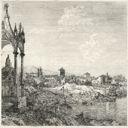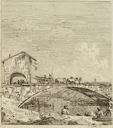Canaletto
Italian
(Venice, Italy, 1697 – 1768)
Giovanni Antonio Canal, called Canaletto, was born in Venice to a set designer, Bernardo Cesare Canal (1674–1744), who trained him in drawing, perspective, and the art of illusionistic scene painting for the theatre. He assisted his father from 1716 to 1718 in Venice, and in Rome in 1719. This early Roman experience was to have a decisive impact on Canaletto, not only for the ancient ruins and monuments he saw in the Eternal City, but also for the view painters of various nationalities who he met there. By about 1720, Canaletto was back in Venice and registered as a member of the Venetian painters’ guild; he studied briefly with Luca Carlevarijs (Italian, 1665–1731), the most famous view painter of the Veneto at the time. By the mid-1720s, Canaletto had become a known painter of the Venetian cityscape, and he entered into an arrangement with an Irish entrepreneur, Owen McSwiney, whose business included acquiring works of art for British collectors. Around 1726, McSwiney commissioned a group of Italian painters to produce a series of canvases (known as “the tomb paintings” because they were intended to commemorate great men of English history) with the intention of marketing them in England. Canaletto’s contribution to this project was minor, but it established his connection to the English clientele who supported his work for the next forty years.
On June 6, 1744, Joseph Smith (English, 1682–1770), a banker, art collector, and publisher, and Canaletto’s most important patron, was appointed English consul in Venice. Sometime after his appointment, Canaletto published a group of 36 etchings known as “Vedute Altre prese da I Luoghi Altre ideate,” (Views, Some Taken from Places, Others Invented.) It is believed that the prints were intended as a financial venture for the artist, as the market for his paintings of Venice had suffered due to the upheaval caused by the War of Austrian Secession in the early1740s. The limited number of surviving examples of the single edition of the “Vedute” suggests that the prints were not commercially successful despite the fact that they are recognized today as a highpoint in the history of the genre. In 1746, Canaletto moved to London, where he painted views of landscapes and cityscapes. He returned to his native city around 1755, and was elected to the Venetian Academy in 1763, remaining active as a painter of views of Venice until his death in 1768.
See "Italian Master Prints of the 18th Century: Selections from the Collection of Mr. and Mrs. Adolph Weil, Jr.," exh. cat., (Montgomery: Montgomery Museum of Fine Arts, 1984), 13, and “Venice in the Age of Canaletto,” exh. cat., (Memphis, TN: Memphis Brooks Museum of Art, 2009),14.
The "Vedute…" consists of 36 plates: 35 views of the city of Venice and one title plate. Four of the plates were printed in only a few impressions and the most commonly seen are 31 plates that were published in significant numbers and distributed more widely. The title plate does not bear a date of publication, but it is believed that the series was published between the date of Smith’s appointment in 1744 and 1746 when Canaletto left for England. See The Courtauld Institute of Art, Art and Architecture database, http://www.artandarchitecture.org.uk/images/gallery/b500c2d2.html accessed October 4, 2013, and Richard Rand and John Varriano, “Two Views of Italy: Master Prints by Canaletto and Piranesi,” Hanover, NH: The Hood Museum of Art, Dartmouth College, 1995, p.34.
Image credit: Antonio Visentini (Italian, 1688–1782), Portrait of Canaletto, 1735, from the series, Prospectus Magni Canalis Venetiarum, etching, Metropolitan Museum of Art, New York, New York, Gift of David and Elizabeth Tunick, 1991.1206.6, Courtesy of Wikimedia Commons, (c) PD-US-expired
Italian
(Venice, Italy, 1697 – 1768)
Giovanni Antonio Canal, called Canaletto, was born in Venice to a set designer, Bernardo Cesare Canal (1674–1744), who trained him in drawing, perspective, and the art of illusionistic scene painting for the theatre. He assisted his father from 1716 to 1718 in Venice, and in Rome in 1719. This early Roman experience was to have a decisive impact on Canaletto, not only for the ancient ruins and monuments he saw in the Eternal City, but also for the view painters of various nationalities who he met there. By about 1720, Canaletto was back in Venice and registered as a member of the Venetian painters’ guild; he studied briefly with Luca Carlevarijs (Italian, 1665–1731), the most famous view painter of the Veneto at the time. By the mid-1720s, Canaletto had become a known painter of the Venetian cityscape, and he entered into an arrangement with an Irish entrepreneur, Owen McSwiney, whose business included acquiring works of art for British collectors. Around 1726, McSwiney commissioned a group of Italian painters to produce a series of canvases (known as “the tomb paintings” because they were intended to commemorate great men of English history) with the intention of marketing them in England. Canaletto’s contribution to this project was minor, but it established his connection to the English clientele who supported his work for the next forty years.
On June 6, 1744, Joseph Smith (English, 1682–1770), a banker, art collector, and publisher, and Canaletto’s most important patron, was appointed English consul in Venice. Sometime after his appointment, Canaletto published a group of 36 etchings known as “Vedute Altre prese da I Luoghi Altre ideate,” (Views, Some Taken from Places, Others Invented.) It is believed that the prints were intended as a financial venture for the artist, as the market for his paintings of Venice had suffered due to the upheaval caused by the War of Austrian Secession in the early1740s. The limited number of surviving examples of the single edition of the “Vedute” suggests that the prints were not commercially successful despite the fact that they are recognized today as a highpoint in the history of the genre. In 1746, Canaletto moved to London, where he painted views of landscapes and cityscapes. He returned to his native city around 1755, and was elected to the Venetian Academy in 1763, remaining active as a painter of views of Venice until his death in 1768.
See "Italian Master Prints of the 18th Century: Selections from the Collection of Mr. and Mrs. Adolph Weil, Jr.," exh. cat., (Montgomery: Montgomery Museum of Fine Arts, 1984), 13, and “Venice in the Age of Canaletto,” exh. cat., (Memphis, TN: Memphis Brooks Museum of Art, 2009),14.
The "Vedute…" consists of 36 plates: 35 views of the city of Venice and one title plate. Four of the plates were printed in only a few impressions and the most commonly seen are 31 plates that were published in significant numbers and distributed more widely. The title plate does not bear a date of publication, but it is believed that the series was published between the date of Smith’s appointment in 1744 and 1746 when Canaletto left for England. See The Courtauld Institute of Art, Art and Architecture database, http://www.artandarchitecture.org.uk/images/gallery/b500c2d2.html accessed October 4, 2013, and Richard Rand and John Varriano, “Two Views of Italy: Master Prints by Canaletto and Piranesi,” Hanover, NH: The Hood Museum of Art, Dartmouth College, 1995, p.34.
Image credit: Antonio Visentini (Italian, 1688–1782), Portrait of Canaletto, 1735, from the series, Prospectus Magni Canalis Venetiarum, etching, Metropolitan Museum of Art, New York, New York, Gift of David and Elizabeth Tunick, 1991.1206.6, Courtesy of Wikimedia Commons, (c) PD-US-expired
Artist Objects







